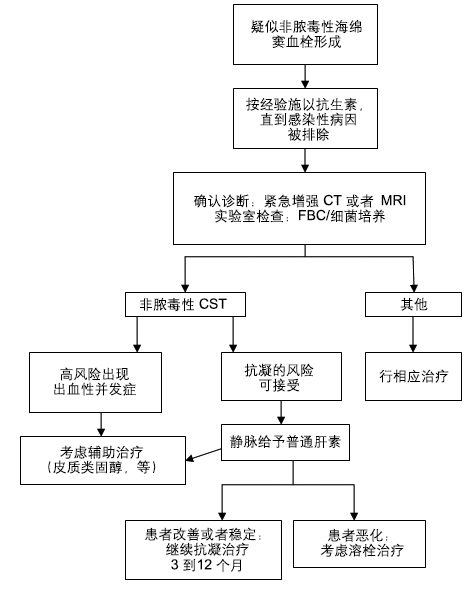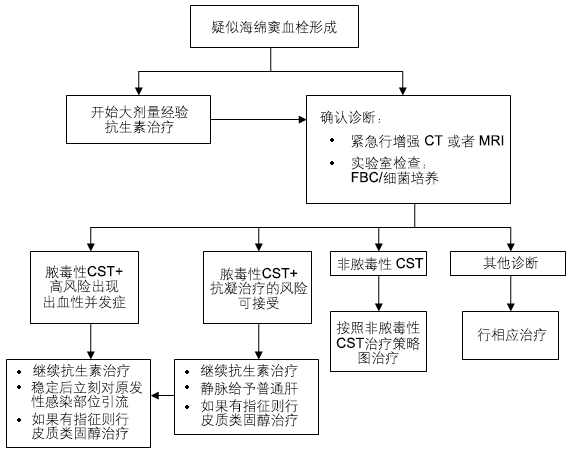海绵窦血栓(CST)的总死亡率和发病率一直很高。[7]Southwick FS, Richardson EP Jr, Swartz MN. Septic thrombosis of the dural venous sinuses. Medicine. 1986;65:82-106.http://www.ncbi.nlm.nih.gov/pubmed/3512953?tool=bestpractice.com因此,应强调对早期疑似病例进行积极治疗的原则。CST的治疗首选抗生素。对于合适的患者,抗凝、皮质类固醇和手术可作为辅助治疗。 [Figure caption and citation for the preceding image starts]: 非脓毒性海绵窦血栓形成(CST)的治疗:由芝加哥大学的Jayant Pinto医生提供 [Citation ends].
[Figure caption and citation for the preceding image starts]: 非脓毒性海绵窦血栓形成(CST)的治疗:由芝加哥大学的Jayant Pinto医生提供 [Citation ends]. [Figure caption and citation for the preceding image starts]: 脓毒性海绵窦血栓形成(CST)的治疗:由芝加哥大学的Jayant Pinto医生提供 [Citation ends]. 因为通常很难辨别CST的脓毒性和非脓毒性病因,因此最初的治疗是相同的。只有当脓毒性病因被绝对排除后,才可以停用抗生素。因此在实践中,脓毒性和非脓毒性疾病的治疗是相同的。
[Figure caption and citation for the preceding image starts]: 脓毒性海绵窦血栓形成(CST)的治疗:由芝加哥大学的Jayant Pinto医生提供 [Citation ends]. 因为通常很难辨别CST的脓毒性和非脓毒性病因,因此最初的治疗是相同的。只有当脓毒性病因被绝对排除后,才可以停用抗生素。因此在实践中,脓毒性和非脓毒性疾病的治疗是相同的。
所有患者的初始治疗
根据病例报道和专家观点,推荐首选抗生素治疗。其能最大改善脓毒性CST的预后。[1]Yarington CT, Jr. Cavernous sinus thrombosis revisited. Proc R Soc Med. 1977;70:456-459.http://www.pubmedcentral.nih.gov/articlerender.fcgi?tool=pubmed&pubmedid=331338http://www.ncbi.nlm.nih.gov/pubmed/331338?tool=bestpractice.com在最早怀疑此诊断时就应及时经静脉大剂量使用抗生素。[1]Yarington CT, Jr. Cavernous sinus thrombosis revisited. Proc R Soc Med. 1977;70:456-459.http://www.pubmedcentral.nih.gov/articlerender.fcgi?tool=pubmed&pubmedid=331338http://www.ncbi.nlm.nih.gov/pubmed/331338?tool=bestpractice.com针对原发感染部位可能的致病菌经验性选择的合适的抗生素。需考虑可能的并发症,比如脑脓肿或者眼眶脓肿、脑膜炎或者硬脑膜下积脓。[29]Ebright JR, Pace MT, Niazi AF. Septic thrombosis of the cavernous sinuses. Arch Intern Med. 2001;161:2671-2676.http://archinte.ama-assn.org/cgi/content/full/161/22/2671http://www.ncbi.nlm.nih.gov/pubmed/11732931?tool=bestpractice.com[41]Bhatia K, Jones NS. Septic cavernous sinus thrombosis secondary to sinusitis: are anticoagulants indicated? A review of the literature. J Laryngol Otol. 2002;116:667-676.http://www.ncbi.nlm.nih.gov/pubmed/12437798?tool=bestpractice.com
金黄色葡萄球菌是最常见的致病菌,出现在大约70%的病例中,并涉及几乎所有的面部感染和蝶窦炎病例。[29]Ebright JR, Pace MT, Niazi AF. Septic thrombosis of the cavernous sinuses. Arch Intern Med. 2001;161:2671-2676.http://archinte.ama-assn.org/cgi/content/full/161/22/2671http://www.ncbi.nlm.nih.gov/pubmed/11732931?tool=bestpractice.com培养出链球菌(包括肺炎链球菌,米勒链球菌以及绿色链球菌组)较少见。偶尔会发现厌氧菌,特别是在鼻窦、牙齿或者扁桃体感染时。在CST中曲霉菌或者毛霉菌导致的真菌感染较罕见。[57]Estrem SA, Tully R, Davis WE. Rhinocerebral mucormycosis: computed tomographic imaging of cavernous sinus thrombosis. Ann Otol Rhinol Laryngol. 1990;99:160-161.http://www.ncbi.nlm.nih.gov/pubmed/2301872?tool=bestpractice.com[58]Dooley DP, Hollsten DA, Grimes SR, et al. Indolent orbital apex syndrome caused by occult mucormycosis. J Clin Neuroophthalmol. 1992;12 245-249.http://www.ncbi.nlm.nih.gov/pubmed/1287049?tool=bestpractice.com 因此,对于大部分病因,经验治疗应该包括:
万古霉素可覆盖潜在的耐甲氧西林金黄色葡萄球菌 (MRSA) 感染,直到获得确切的培养结果。[59]Naesens R, Ronsyn M, Druwé P, et al. Central nervous system invasion by community-acquired meticillin-resistant Staphylococcus aureus. J Med Microbiol. 2009;58:1247-1251.http://jmm.sgmjournals.org/content/58/9/1247.full.pdfhttp://www.ncbi.nlm.nih.gov/pubmed/19528145?tool=bestpractice.com[60]Dylewski J, Martel G. A case of spontaneous methicillin-resistant Staphylococcus aureus meningitis in a health care worker. Can J Infect Dis Med Microbiol. 2004;15:336-338.http://www.ncbi.nlm.nih.gov/pmc/articles/PMC2094991/pdf/JIDMM15336.pdfhttp://www.ncbi.nlm.nih.gov/pubmed/18159511?tool=bestpractice.com加
第三代头孢菌素,比如头孢曲松(只能用于无青霉素过敏史的患者)。确实对青霉素过敏的患者,应替代使用氟喹诺酮类药物。
如果怀疑牙源性或者鼻窦感染,应静脉使用甲硝唑。只有在活检确认侵袭性真菌感染时,才可以进行抗真菌治疗。因为在社区中MRSA感染率升高,最好使用万古霉素直到获得培养结果。对于不能应用青霉素和头孢菌素或者应用后无效的患者,也可以使用万古霉素。一旦实验室报告药敏结果,经验性的抗生素应该换为特异性的抗生素治疗。
需要大剂量使用静脉抗生素,这是因为血栓可能会限制抗生素的渗透。隐蔽在血栓中的细菌可能未被杀死,直到硬脑膜窦开始再通。同时需要长期使用抗生素,在临床治愈后至少还需要使用两周。[7]Southwick FS, Richardson EP Jr, Swartz MN. Septic thrombosis of the dural venous sinuses. Medicine. 1986;65:82-106.http://www.ncbi.nlm.nih.gov/pubmed/3512953?tool=bestpractice.com其目的是为了确保完全杀灭细菌,防止复发。同时需要进行支持治疗,包括复苏、吸氧和局部眼部治疗。
辅助性治疗:抗凝疗法
对于CST的治疗中抗凝疗法的作用存在较大争议。由于此疾病罕见,因此从未进行过(也不可能进行)判断抗凝疗法的益处的前瞻性研究。抗凝疗法有出血风险,特别是伴随有并发症的患者(比如,皮质静脉梗死、海绵窦段部分颈内动脉坏死以及颅内或者眶内出血)。[41]Bhatia K, Jones NS. Septic cavernous sinus thrombosis secondary to sinusitis: are anticoagulants indicated? A review of the literature. J Laryngol Otol. 2002;116:667-676.http://www.ncbi.nlm.nih.gov/pubmed/12437798?tool=bestpractice.com然而,有证据表明使用抗凝剂可以防止感染播散,有助于血栓再通。这些潜在的益处部分是因为血栓自身可以藏匿细菌,并为其生长提供营养。[1]Yarington CT, Jr. Cavernous sinus thrombosis revisited. Proc R Soc Med. 1977;70:456-459.http://www.pubmedcentral.nih.gov/articlerender.fcgi?tool=pubmed&pubmedid=331338http://www.ncbi.nlm.nih.gov/pubmed/331338?tool=bestpractice.com两篇评估抗凝疗法对脓毒性CST疗效的回顾性综述得出了不同的结果。海绵窦血栓患者(CST)的死亡率和发病率:来自一系列少量病例的低级别证据显示,抗凝结合抗生素较单独使用抗生素治疗并未降低死亡率。[14]Levine SR, Twyman RE, Gilman S. The role of anticoagulation in cavernous sinus thrombosis. Neurology. 1988;38:517-522.http://www.ncbi.nlm.nih.gov/pubmed/3281056?tool=bestpractice.com尽管在另一系列病例报道中,早期单侧脓毒性CST的患者死亡率有所下降。[7]Southwick FS, Richardson EP Jr, Swartz MN. Septic thrombosis of the dural venous sinuses. Medicine. 1986;65:82-106.http://www.ncbi.nlm.nih.gov/pubmed/3512953?tool=bestpractice.com有低级别证据证明早期抗凝疗法与某些病症的发生率降低有关(比如,眼肌麻痹、卒中、垂体功能不全)。[14]Levine SR, Twyman RE, Gilman S. The role of anticoagulation in cavernous sinus thrombosis. Neurology. 1988;38:517-522.http://www.ncbi.nlm.nih.gov/pubmed/3281056?tool=bestpractice.com低质量的观察性(队列)研究或者受试者<200名且方法学存在缺陷的随机对照临床试验(RCT)。
目前正在累积其他硬脑膜静脉窦血栓中抗凝疗法作用的证据。已有两个对照试验比较了脑静脉窦血栓形成患者中安慰剂与抗凝剂的作用。[61]de Bruijn SF, Stam J. Randomized, placebo-controlled trial of anticoagulant treatment with low-molecular-weight heparin for cerebral sinus thrombosis. Stroke. 1999;30:484-488.http://stroke.ahajournals.org/content/30/3/484.full.pdfhttp://www.ncbi.nlm.nih.gov/pubmed/10066840?tool=bestpractice.com[62]Einhäupl KM, Villringer A, Meister W, et al. Heparin treatment in sinus venous thrombosis. Lancet. 1991;338:597-600. Erratum in: Lancet 1991;338:958.http://www.ncbi.nlm.nih.gov/pubmed/1679154?tool=bestpractice.com 欧洲神经病学联盟(EFNs)指南推荐皮下或者静脉使用低分子肝素治疗非脓毒性硬脑膜静脉血栓。[63]Einhäupl K, Stam J, Bousser MG, et al; European Federation of Neurological Societies. EFNS guideline on the treatment of cerebral venous and sinus thrombosis in adult patients. Eur J Neurol. 2010;17:1229-1235.http://www.efns.org/fileadmin/user_upload/guidline_papers/EFNS_guideline_2010_treatment_of_cerebral_venous_and_sinus_thrombosis.pdfhttp://www.ncbi.nlm.nih.gov/pubmed/20402748?tool=bestpractice.com类似的,2012年欧洲儿科神经病学会(EPNS)指南推荐使用抗凝剂治疗硬脑膜静脉血栓以降低死亡和其他后遗症的风险。[64]Lebas A, Chabrier S, Fluss J, et al. French Society for Paediatric Neurology; European Paediatric Neurology Society. EPNS/SFNP guideline on the anticoagulant treatment of cerebral sinovenous thrombosis in children and neonates. Eur J Paediatr Neurol. 2012;16:219-228.http://www.ncbi.nlm.nih.gov/pubmed/22425391?tool=bestpractice.com然而,应注意脓毒性CST和非脓毒性硬膜静脉血栓在许多方面不同,在脓毒性CST患者中抗凝疗法风险更大。[41]Bhatia K, Jones NS. Septic cavernous sinus thrombosis secondary to sinusitis: are anticoagulants indicated? A review of the literature. J Laryngol Otol. 2002;116:667-676.http://www.ncbi.nlm.nih.gov/pubmed/12437798?tool=bestpractice.com其区别包括感染性的病因、血栓的部位、病程的缓急以及是否出现相关的出血性并发症。[41]Bhatia K, Jones NS. Septic cavernous sinus thrombosis secondary to sinusitis: are anticoagulants indicated? A review of the literature. J Laryngol Otol. 2002;116:667-676.http://www.ncbi.nlm.nih.gov/pubmed/12437798?tool=bestpractice.com
基于有限的观察,在行CT扫描排除出血性并发症后,抗凝治疗可能有益。[1]Yarington CT, Jr. Cavernous sinus thrombosis revisited. Proc R Soc Med. 1977;70:456-459.http://www.pubmedcentral.nih.gov/articlerender.fcgi?tool=pubmed&pubmedid=331338http://www.ncbi.nlm.nih.gov/pubmed/331338?tool=bestpractice.com[7]Southwick FS, Richardson EP Jr, Swartz MN. Septic thrombosis of the dural venous sinuses. Medicine. 1986;65:82-106.http://www.ncbi.nlm.nih.gov/pubmed/3512953?tool=bestpractice.com[14]Levine SR, Twyman RE, Gilman S. The role of anticoagulation in cavernous sinus thrombosis. Neurology. 1988;38:517-522.http://www.ncbi.nlm.nih.gov/pubmed/3281056?tool=bestpractice.com 有学者认为在双侧CST和/或并发颅内出血的患者中使用抗凝疗法是危险的。
不同研究方案中的抗凝疗法其类型和用药方案区别相当大。静脉和肌注普通肝素、皮下低分子量肝素(LMWH)以及口服抗凝剂均有使用。然而,在疾病的早期阶段提倡使用短效可逆的药物,比如静脉使用普通肝素,当患者情况稳定后,再更换长效药物,比如华法林。[41]Bhatia K, Jones NS. Septic cavernous sinus thrombosis secondary to sinusitis: are anticoagulants indicated? A review of the literature. J Laryngol Otol. 2002;116:667-676.http://www.ncbi.nlm.nih.gov/pubmed/12437798?tool=bestpractice.com
新型抗凝剂,包括直接凝血酶抑制剂,Xa因子抑制剂,较肝素有许多优点,包括更可预计的抗凝效果,不会引发免疫介导的肝素诱导性血小板减少症(HIT)。[65]Direct Thrombin Inhibitor Trialists' Collaborative Group. Direct thrombin inhibitors in acute coronary syndromes: principal results of a meta-analysis based on individual patients' data. Lancet. 2002;359:294-302.http://www.ncbi.nlm.nih.gov/pubmed/11830196?tool=bestpractice.com但是,缺少使用这些制剂治疗CST或者其他类型硬脑膜静脉窦血栓的病例报告。在HIT患者或者具有HIT风险的患者中可使用直接凝血酶抑制剂,比如阿加曲班,做为替代肝素的一种抗凝剂。
抗凝时间尚不确定,文献报道从几个星期到几个月不等。一些作者建议抗凝治疗应持续至临床或影像学证据证明完全缓解或者感染和血栓显著改善。
开始抗凝治疗的患者通常仍处于不稳定的临床状态,因此不适合进行手术治疗。但是,如果患者状态稳定,有手术指征,可以停用短效可逆性抗凝剂,以进行手术。
如果认为患者适合进行抗凝疗法,但是在治疗中病情仍恶化,可考虑进行溶栓。[66]Liebetrau M, Mayer TE, Bruning R, et al. Intra-arterial thrombolysis of complete deep cerebral venous thrombosis. Neurology. 2004;63:2444-2445.http://www.ncbi.nlm.nih.gov/pubmed/15623729?tool=bestpractice.com[67]Canhão P, Falcão F, Ferro JM. Thrombolytics for cerebral sinus thrombosis: a systematic review. Cerebrovasc Dis. 2003;15:159-166.http://www.ncbi.nlm.nih.gov/pubmed/12646773?tool=bestpractice.com 该疗法通常仅用于治疗进行性加重的非脓毒性CST,有颅内出血、卒中以及血栓未能再通的风险。可以使用皮质类固醇。
辅助性治疗:皮质类固醇
皮质类固醇的作用在许多CST病例中存在争议。因为其具有免疫抑制作用,所以可能有害。然而,垂体功能不全是使用皮质类固醇的绝对适应症。垂体缺血或坏死可导致急性肾上腺皮质危象,使得CST更为复杂,皮质类固醇在此类患者中可能发挥关键作用。[68]Silver HS, Morris LR. Hypopituitarism secondary to cavernous sinus thrombosis. South Med J. 1983;76:642-646.http://www.ncbi.nlm.nih.gov/pubmed/6302919?tool=bestpractice.com[69]Sahjpaul RL, Lee DH. Infratentorial subdural empyema, pituitary abscess, and septic cavernous sinus thrombophlebitis secondary to paranasal sinusitis: case report. Neurosurgery. 1999;44:864-866; discussion 866-868.http://www.ncbi.nlm.nih.gov/pubmed/10201313?tool=bestpractice.com
虽然其抗炎作用可能只有经验支持,并且有导致全身性脓毒症的担忧,但皮质类固醇也有以下益处:
减轻眼眶水肿患者的眶内充血
减轻颅神经功能障碍患者的颅神经炎症。
只有少数个案报告提及了在CST中全身使用皮质类固醇,这些报告尚不能证实其效果。在这些研究中,皮质类固醇的使用和其他治疗同时进行。[7]Southwick FS, Richardson EP Jr, Swartz MN. Septic thrombosis of the dural venous sinuses. Medicine. 1986;65:82-106.http://www.ncbi.nlm.nih.gov/pubmed/3512953?tool=bestpractice.com[31]Gallagher RM, Gross CW, Phillips CD. Suppurative intracranial complications of sinusitis. Laryngoscope. 1998;108:1635-1642.http://www.ncbi.nlm.nih.gov/pubmed/9818818?tool=bestpractice.com[70]Clifford-Jones RE, Ellis CJ, Stevens JM, et al. Cavernous sinus thrombosis. J Neurol Neurosurg Psychiaty. 1982;45:1092-1097.http://www.pubmedcentral.nih.gov/articlerender.fcgi?artid=491689http://www.ncbi.nlm.nih.gov/pubmed/7161604?tool=bestpractice.com[71]Igarashi H, Igarashi S, Fujio N, et al. Magnetic resonance imaging in the early diagnosis of cavernous sinus thrombosis. Ophthalmologica. 1995;209:292-296.http://www.ncbi.nlm.nih.gov/pubmed/8570157?tool=bestpractice.com1962年报道的1例病例中,颅神经功能障碍和眼眶水肿在37日的抗生素和抗凝治疗之后没有得到改善,但是在皮质类固醇治疗2日后显著好转,最终眼部症状和体征完全消失。[72]Solomon OD, Moses L, Volk M. Steroid therapy in cavernous sinus thrombosis. Am J Ophthalmol. 1962;54:1122-1124.http://www.ncbi.nlm.nih.gov/pubmed/13978082?tool=bestpractice.com
稳定后进一步的治疗
最后,只要患者病情允许,建议立刻进行原发感染部位(比如,副鼻窦炎、牙脓肿)或者其他并发的邻近部位感染的引流。[7]Southwick FS, Richardson EP Jr, Swartz MN. Septic thrombosis of the dural venous sinuses. Medicine. 1986;65:82-106.http://www.ncbi.nlm.nih.gov/pubmed/3512953?tool=bestpractice.com[2]DiNubile MJ. Septic thrombosis of the cavernous sinuses. Arch Neurol. 1988;45:567-572.http://www.ncbi.nlm.nih.gov/pubmed/3282499?tool=bestpractice.com[73]Mahapatra AK. Brain abscess-an unusual complication of cavernous sinus thrombosis. A case report. Clin Neurol Neurosurg. 1988;90:241-243.http://www.ncbi.nlm.nih.gov/pubmed/3197350?tool=bestpractice.com
在鼻源性CST中,建议对所有病例进行鼻窦手术通畅引流。[6]Dolan RW, Chowdhury K. Diagnosis and treatment of intracranial complications of paranasal sinus infections. J Oral Maxillofac Surg. 1995;53:1080-1087.http://www.ncbi.nlm.nih.gov/pubmed/7643279?tool=bestpractice.com采用不同的术式减压鼻窦,包括经鼻中隔蝶窦切除术、鼻内镜下蝶窦切除术和筛窦切除术以及外入路额-筛-蝶窦切除术。对耳源性CST患者行乳突根治术,减压乙状窦改善血栓性静脉炎。[34]Doyle KJ, Jackler RK. Otogenic cavernous sinus thrombosis. Otolaryngol Head Neck Surg. 1991;104:873-877.http://www.ncbi.nlm.nih.gov/pubmed/1908984?tool=bestpractice.com
 [Figure caption and citation for the preceding image starts]: 非脓毒性海绵窦血栓形成(CST)的治疗:由芝加哥大学的Jayant Pinto医生提供 [Citation ends].
[Figure caption and citation for the preceding image starts]: 非脓毒性海绵窦血栓形成(CST)的治疗:由芝加哥大学的Jayant Pinto医生提供 [Citation ends]. [Figure caption and citation for the preceding image starts]: 脓毒性海绵窦血栓形成(CST)的治疗:由芝加哥大学的Jayant Pinto医生提供 [Citation ends]. 因为通常很难辨别CST的脓毒性和非脓毒性病因,因此最初的治疗是相同的。只有当脓毒性病因被绝对排除后,才可以停用抗生素。因此在实践中,脓毒性和非脓毒性疾病的治疗是相同的。
[Figure caption and citation for the preceding image starts]: 脓毒性海绵窦血栓形成(CST)的治疗:由芝加哥大学的Jayant Pinto医生提供 [Citation ends]. 因为通常很难辨别CST的脓毒性和非脓毒性病因,因此最初的治疗是相同的。只有当脓毒性病因被绝对排除后,才可以停用抗生素。因此在实践中,脓毒性和非脓毒性疾病的治疗是相同的。